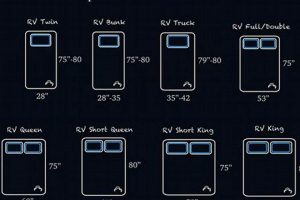The dimensions of a mattress intended for toddlers generally adhere to a standard of approximately 28 inches wide and 52 inches long. This measurement corresponds directly to the interior space of a standard-sized crib, thereby facilitating a smooth transition for the child as they move from crib to a toddler bed. For instance, a parent purchasing bedding marketed for toddlers can expect it to fit this specified surface area.
Adhering to a defined bed dimension is essential for safety and practicality. It ensures appropriate fit within designated toddler beds, minimizing gaps that could pose entrapment risks. Furthermore, consistent dimensions allow for easy selection of fitted sheets and bedding accessories. Historically, this standardized measurement has evolved in response to safety regulations and the need for readily available compatible products.
Therefore, selecting bedding designed for young children involves understanding these standard measurements. Further exploration of this topic will cover considerations for mattress types, materials, and safety certifications relevant to selecting the optimal product for a growing child.
Selecting the Correct Toddler Mattress Dimensions
The following points provide guidance on choosing a mattress designed for toddler use, emphasizing safety and suitability for the intended bed frame.
Tip 1: Verify Standard Dimensions: Ensure the mattress measures approximately 28 inches by 52 inches. This is the established standard for toddler beds and crib conversions.
Tip 2: Confirm Bed Frame Compatibility: Before purchasing, verify that the chosen mattress fits the interior dimensions of the toddler bed frame. Small gaps can present safety hazards.
Tip 3: Prioritize Firmness: Select a firm mattress that provides adequate support for a developing spine. Soft mattresses can increase the risk of suffocation.
Tip 4: Check for Certifications: Look for certifications such as GREENGUARD Gold or CertiPUR-US, indicating the mattress has been tested for harmful chemicals and emissions.
Tip 5: Consider Mattress Depth: Pay attention to the mattress’s thickness to ensure it does not exceed the safe height limit for the toddler bed rails.
Tip 6: Inspect for Quality Construction: Assess the mattress for durable seams and overall construction to ensure it can withstand regular use.
Adhering to these guidelines will help ensure the selected mattress not only fits properly within the toddler bed frame, but also offers a secure and supportive sleep surface for the child.
Further discussion will address specific mattress materials and construction techniques to further refine the selection process.
1. Standard dimensions (28" x 52")
The “standard dimensions (28″ x 52″)” represent the most critical and defining characteristic of a toddler mattress. These measurements dictate its interchangeability with cribs and dedicated toddler beds, representing a critical baseline for safety and functionality.
- Crib Conversion Compatibility
These specific dimensions are directly derived from the interior dimensions of a standard-sized crib. This enables the existing crib frame to be converted into a toddler bed simply by lowering one side rail, eliminating the need for an entirely new bed purchase. This conversion is a practical approach, utilizing existing furniture to save cost.
- Toddler Bed Frame Fit
Dedicated toddler bed frames are designed around these dimensions. This ensures a snug fit for the mattress, minimizing gaps between the mattress and the frame. These gaps can pose entrapment hazards for young children, making a proper fit essential for safety and regulatory compliance.
- Bedding Standardization
The established measurements allow for standardized manufacturing of fitted sheets and other bedding accessories. This provides parents with a wide variety of readily available options and guarantees that these items will fit the mattress correctly. Deviation from these measurements would necessitate custom-sized bedding, increasing costs and limiting availability.
- Safety Regulations and Standards
Many regulatory bodies and safety organizations recognize these dimensions as the de facto standard for toddler mattresses. This adherence allows for consistent safety testing and certification processes, ensuring that mattresses marketed for toddlers meet certain safety requirements regarding flammability, off-gassing, and other potential hazards.
In conclusion, the “standard dimensions (28″ x 52″)” are not merely arbitrary measurements; they represent the cornerstone of the toddler mattress category, influencing compatibility, safety, bedding availability, and regulatory compliance. This standardization allows for ease of use and guarantees parents that the selected mattress meets certain recognized benchmarks. Deviations from these measurements should be carefully considered in light of the potential safety implications.
2. Crib compatibility
The relationship between crib compatibility and the dimensions of a toddler mattress is fundamental. The standard dimensions (approximately 28 inches wide and 52 inches long) directly originate from the internal measurements of a standard-size crib. This correspondence is not coincidental; it’s a deliberate design element that facilitates the transition from crib to toddler bed. The intended cause is a seamless transfer for the child as they graduate from crib to the next stage. One effect is that a parent can reuse the existing crib frame, converting it into a toddler bed simply by removing or lowering one side rail. This feature provides a cost-effective solution for parents, eliminating the necessity to purchase a completely new bed. Bedding manufacturers utilize this standard to create compatible products. If these dimensions deviated, fitted sheets and other accessories would not fit correctly, rendering them useless.
Another example of this compatibility lies in the safety benefits. Toddler beds are often converted cribs, the dimensions ensuring minimal gaps between the mattress and frame. A gap poses a potential entrapment hazard, where a child could become stuck, potentially leading to injury. This safety consideration drives the adherence to standardized measurements within the industry. The correlation between mattress size and crib dimensions means that the correct sheets and covers can be used, enhancing mattress hygiene and longevity. These are also easier to find with standardized sizing, and available at more retailers.
In summary, the inherent connection between crib compatibility and toddler mattress measurements is crucial for both practical and safety reasons. These dimensions allow for a smooth transition, offer cost savings, minimize safety hazards, and promote convenience in bedding selection. The relationship highlights the importance of adhering to established standards in the manufacture of products designed for young children. The challenge remains ensuring that consumers fully understand the significance of these standard sizes when making purchasing decisions, particularly when considering non-standard or imported products.
3. Bed frame fit
The concept of bed frame fit is intrinsically linked to toddler mattress size. The dimensions of a toddler mattress are standardized to match the interior dimensions of toddler bed frames, whether these are dedicated toddler beds or converted cribs. The cause-and-effect relationship is straightforward: a mattress designed to the specified dimensions (approximately 28″ x 52″) will fit correctly within a bed frame also manufactured to accommodate those dimensions. The importance of this fit cannot be overstated. A properly fitted mattress eliminates or minimizes gaps between the mattress and the bed frame. These gaps present a potential entrapment hazard for young children, who may become wedged between the mattress and the frame. For example, consider a scenario where a toddler rolls over in their sleep and becomes trapped in a gap; this could lead to discomfort, injury, or even suffocation. Therefore, precise bed frame fit is a critical safety component of using the correct toddler mattress size. Furthermore, a well-fitted mattress provides stable and even support, which is necessary for the proper development of a child’s spine.
Real-world applications of this understanding are evident in the design and manufacturing of toddler beds. Manufacturers adhere to specific dimensional tolerances to ensure compatibility between their beds and standard toddler mattresses. This adherence allows parents to purchase mattresses and bed frames with the assurance that they will fit together correctly. Many regulatory bodies and safety organizations impose standards for the acceptable gap size between a mattress and bed frame. These regulations are directly tied to preventing entrapment hazards. Inspection of this fit is always recommended when installing a new mattress.
In summary, the relationship between bed frame fit and toddler mattress size is essential for safety, support, and regulatory compliance. The proper fit minimizes the risk of entrapment and ensures stable sleep. A challenge lies in ensuring that consumers are fully aware of these standards and understand the importance of accurate measurement when selecting a mattress for their child’s bed. The consumer needs to inspect after assembly to be certain. Deviations from standard dimensions or poorly designed bed frames can compromise safety and should be carefully avoided. This understanding underscores the broader theme of prioritizing safety and well-being in the selection of products designed for young children.
4. Thickness/height
The thickness or height of a mattress is an intrinsic component of its overall dimensions and functionality, particularly in the context of a toddler mattress. While the length and width define the surface area, the thickness determines the mattress’s volume and its interaction with the surrounding bed frame. The height of a toddler mattress is significant as it influences the effectiveness of the bed’s safety rails. If a mattress is too thick, it can reduce the height of the rails, potentially allowing a child to roll over the side. Conversely, a mattress that is too thin may not provide adequate support and could compromise safety by increasing the gap between the mattress and the rails. The standard sizes exist to make finding a properly sized mattress straightforward.
The relationship between mattress thickness and bed rail height is regulated by safety standards. These standards specify maximum mattress thicknesses to ensure that the rails maintain adequate protection. For instance, a toddler bed with a rail height of ‘x’ inches may stipulate that the mattress thickness not exceed ‘y’ inches, where ‘y’ is calculated to maintain a safe rail height above the sleeping surface. Adherence to these standards is paramount in mitigating the risk of falls. Furthermore, the mattresss internal composition also influences its performance and support, even with proper dimensions. A mattress’s thickness also determines its weight and how easy to manipulate it.
In summary, the thickness of a toddler mattress is a key dimension that must be considered alongside its length and width. Optimal thickness is crucial for safety, ensuring that the mattress is neither too high, compromising rail protection, nor too low, providing inadequate support. Regulatory standards provide guidelines for appropriate thickness ranges. The interplay between mattress thickness and rail height underscores the necessity of selecting a mattress that adheres to established safety benchmarks. It ensures a safe sleep environment for the child.
5. Weight capacity
Weight capacity is a critical, though often overlooked, parameter directly pertinent to toddler mattress size. While the physical dimensions of the mattress determine fit, the weight capacity dictates its structural integrity and long-term suitability for supporting a growing child. Overlooking this specification can lead to premature mattress degradation and potential safety hazards.
- Support and Spinal Alignment
The weight capacity of a toddler mattress is engineered to provide adequate support for a child within a specific weight range. Exceeding this weight can cause the mattress to sag or compress unevenly, leading to inadequate spinal alignment during sleep. Over time, this can contribute to discomfort and potentially affect the child’s posture. For instance, a mattress rated for 50 pounds that is consistently subjected to 60 pounds will likely exhibit reduced support and uneven wear.
- Material Durability and Longevity
Weight capacity is directly related to the materials used in the construction of the mattress. A higher weight capacity generally indicates more robust materials and construction techniques, resulting in increased durability and a longer lifespan. A mattress designed with low-density foam and a low weight limit will likely deteriorate faster than one constructed with high-density foam and a corresponding higher limit. The expected durability decreases significantly if the weight limit is regularly exceeded.
- Safety and Structural Integrity
Exceeding the weight capacity of a toddler mattress can compromise its structural integrity. This can lead to internal damage, such as broken coils or compressed foam, which may not be immediately visible. Such damage can create uneven surfaces or potential hazards, such as protruding components. A scenario where a spring breaks due to excessive weight poses a direct risk of injury to the child.
- Co-Sleeping Considerations
If co-sleeping or occasional parental presence on the toddler mattress is anticipated, the weight capacity becomes even more critical. The mattress must be able to safely support the combined weight of the child and adult without compromising its structural integrity or support. Failure to account for this can quickly degrade the mattress and negate any warranties. The long-term implications should be considered before co-sleeping in these circumstances.
In summation, while toddler mattress size dictates physical compatibility with the bed frame, weight capacity is a crucial factor in ensuring the mattress provides adequate support, maintains its structural integrity, and offers a safe sleep environment for the child over its intended lifespan. The relationship between these factors must be carefully considered during the selection process to guarantee the child’s well-being and the product’s longevity. The weight limit must be consulted and checked regularly, with the mattress replaced when that becomes inappropriate.
6. Edge support
Edge support, while often a secondary consideration, is a significant factor in the overall safety and functionality of a toddler mattress. Its relevance stems from the inherent behaviors of young children and the specific dimensions defining the sleep surface.
- Stability and Roll-Off Prevention
Adequate edge support minimizes the likelihood of a child rolling off the mattress, particularly during sleep. Toddlers often move freely and unpredictably throughout the night, making strong edge support crucial for maintaining them within the confines of the mattress. Weak edge support can cause the mattress to compress significantly near the edges, creating a slope that increases the risk of accidental falls. Stronger materials must be used here to assure stability and prevent injury.
- Usable Surface Area
Effective edge support maximizes the usable surface area of the toddler mattress. Without sufficient support, the edges of the mattress may compress excessively under minimal weight, rendering that portion of the mattress unusable. This reduces the effective sleeping area and may lead the child to gravitate toward the center, increasing the risk of rolling off. A mattress with reinforced edges allows the child to utilize the entire surface, promoting comfort and stability.
- Durability and Sag Prevention
Edge support contributes significantly to the overall durability and longevity of the toddler mattress. Reinforced edges prevent sagging and deformation over time, particularly along the perimeter. Continuous compression along the edges, without adequate support, will accelerate wear and tear, reducing the mattress’s lifespan. A well-constructed edge support system helps maintain the mattress’s shape and integrity, extending its usability.
- Ease of Entry and Exit
Stable edge support facilitates easier entry and exit from the toddler bed. A firm edge provides a stable surface for the child to sit on while getting in or out of bed. This is especially important for young children who may lack the coordination and balance of older individuals. Weak edge support can cause the mattress to wobble or compress unevenly, making it difficult and potentially unsafe for the child to enter or exit the bed independently. The firmness helps them to support themselves.
In conclusion, the level of edge support directly impacts safety, usability, durability, and ease of access in toddler mattresses. While the dimensions of the mattress define the available space, the quality of the edge support determines how effectively that space can be utilized and how safely the mattress can perform its intended function. This parameter should be carefully considered when selecting a mattress to ensure a secure sleep environment.
7. Corner radius
Corner radius, while seemingly a minor detail, holds significance within the comprehensive consideration of toddler mattress size. This feature influences safety, fit, and the overall aesthetic integration of the mattress within a toddler bed frame.
- Safety Considerations
A well-defined corner radius mitigates the risk of sharp corners, which could pose a hazard to toddlers. A rounded corner is less likely to cause injury if a child bumps into it. This is particularly pertinent for active toddlers who may move around frequently in their sleep or play near the bed. A larger radius increases the surface area of the impact, distributing force and reducing the likelihood of cuts or abrasions.
- Fit within Bed Frame
The corner radius affects how snugly the mattress fits within the corresponding bed frame. Ideally, the mattress corners should align closely with the corners of the frame to prevent gaps. A poorly matched corner radius, whether too large or too small, can create spaces where a child could potentially become trapped. Therefore, manufacturers often design mattresses and bed frames with complementary corner radii to ensure a secure and seamless fit.
- Aesthetic Integration
Corner radius plays a role in the overall aesthetic appearance of the mattress and bed ensemble. A rounded corner often provides a softer, more child-friendly appearance, aligning with typical design preferences for children’s furniture. Sharper corners, while potentially more modern in style, may appear less inviting in a child’s room. The consistency of the corner radius with the bed frame design contributes to a harmonious and visually appealing sleep environment.
- Manufacturing Precision
Precise corner radius dimensions are indicative of quality manufacturing processes. Consistent and accurate corner radii demonstrate attention to detail and adherence to design specifications. Variability in corner radii within a batch of mattresses could signal inconsistencies in production and potentially compromise overall quality. Corner radius consistency also affects the fit with accessories like fitted sheets, that may not work well with an inconsistent product.
These facets underscore that corner radius, despite its subtlety, is a critical design element in toddler mattresses. It contributes significantly to safety, compatibility, and the overall aesthetic experience. The careful consideration of corner radius reflects the manufacturer’s commitment to providing a well-designed and safe product for young children.
Frequently Asked Questions
The following section addresses common inquiries concerning the dimensions of mattresses designed for toddlers, emphasizing safety and compatibility.
Question 1: What are the standard dimensions for a toddler mattress?
The generally accepted dimensions are approximately 28 inches in width and 52 inches in length. These dimensions are based on the interior measurements of standard-sized cribs.
Question 2: Why is toddler mattress size standardization important?
Standardization ensures compatibility with toddler bed frames and converted cribs. This minimizes gaps that could pose entrapment hazards and allows for easy selection of appropriately sized bedding.
Question 3: Can a standard crib mattress be used in a toddler bed?
Generally, yes. A standard crib mattress is designed to fit both standard cribs and toddler beds, given that toddler beds often result from converting standard-sized cribs.
Question 4: What should be done if the mattress does not fit snugly in the toddler bed frame?
If significant gaps are present, an alternative mattress that better conforms to the frame’s dimensions should be sought. Gaps between the mattress and frame can present a safety risk.
Question 5: Does the thickness of a toddler mattress affect safety?
Yes, mattress thickness can affect safety, specifically in relation to the height of the bed rails. A mattress that is too thick may reduce the effectiveness of the rails, potentially increasing the risk of a child rolling out of bed.
Question 6: Where can information regarding the appropriate toddler mattress size for a specific bed frame be found?
The manufacturer’s documentation for the bed frame usually specifies the recommended mattress size and thickness. Consulting this information prior to purchase is advisable.
The preceding questions highlight crucial factors in selecting a safe and appropriate mattress. Precise dimensions and proper fit are key.
The next section will explore various toddler mattress types and materials, further informing the selection process.
Toddler Mattress Size
The preceding discussion has underscored the significance of precise dimensions in selecting a mattress intended for toddlers. Toddler mattress size, defined by established standards, directly impacts safety, bed frame compatibility, bedding options, and long-term support. Deviations from these standards present potential hazards, while adherence promotes a secure and developmentally sound sleep environment.
Given the inherent vulnerabilities of young children, meticulous attention to mattress specifications is paramount. Further research into specific materials, certifications, and safety guidelines remains essential to ensure optimal well-being. The selection of a toddler mattress transcends mere convenience; it represents a commitment to safeguarding a child’s health and fostering healthy development through restful and secure sleep.


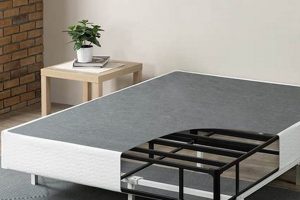
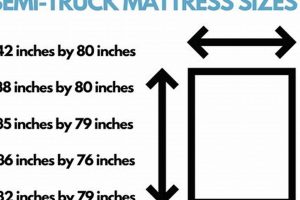
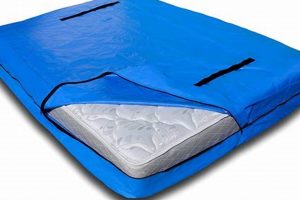
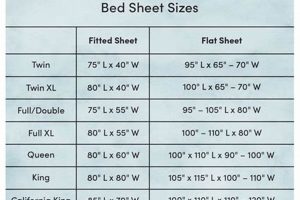
![Best Hybrid Queen Mattress [Year]: Comfort & Support Organic & Natural Mattress Buyer’s Guide: Non-Toxic Sleep Solutions Best Hybrid Queen Mattress [Year]: Comfort & Support | Organic & Natural Mattress Buyer’s Guide: Non-Toxic Sleep Solutions](https://mattressworldpa.com/wp-content/uploads/2025/07/th-2259-300x200.jpg)
